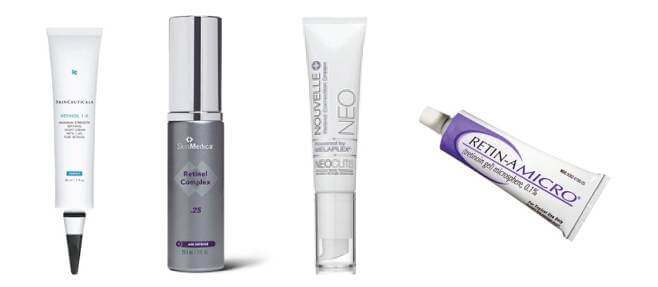Skin Care Ingredients That Don’t Work Well Together

Are you sabotaging your skin by using a bad combination of skin care ingredients? Contrary to popular belief, not all skin care ingredients are meant to be used together. Also, when it comes to skin care it’s important to remember that more is not always better. To get the best results from your skin care regimen its vital to choose products tailored to your specific skin type as well as products that complement each other.
Here’s a look at some common skin care active ingredients that simply do not work well together:
Retinol and Vitamin C
Retinol is a dermatologist’s go-to for treating acne, wrinkles, dark spots and uneven skin texture. Vitamin C also evens out skin texture and resolves discoloration, but works differently.
A derivative of Vitamin A, retinol works best in a high alkaline, or high pH environment. Vitamin C is the opposite, preferring an acidic environment in which to work its antioxidant magic. If you use them both at the same time, neither will give you optimal results.
The Solution? Use products with Vitamin C in the morning to protect your skin from environmental free-radicals. In the evening, use retinol to repair your skin while you sleep.
Niacinamide and Vitamin C
Niacinamide, or Vitamin B3, can even out skin tone and reduce the appearance of pores and wrinkles. Both Niacinamide and Vitamin C are antioxidants, but they just aren’t chemically compatible. Using one right after the other can reduce the potency of both.
Vitamin C does not conflict with niacinamide when used in its gel form, such as ascorbic or l-ascorbic acid.
The Solution? Use Vitamin C in the morning and Niacinamide at night, or alternate your morning products every other day.
Soap Cleansers and Vitamin C
Most products containing Vitamin C are designed to be used in the morning, to protect skin from exposure to daily pollutants. But applying a Vitamin C serum right after washing with soap can diminish the effect of the product.
Vitamin C flourishes in a high acidic environment, yet soap cleansers have a high pH, which can limit absorption of Vitamin C.
The solution? Find a morning cleanser that offers a neutral pH. If you’re married to your AHA or BHA cleanser, choose one with a low percentage of active ingredient to prevent over-drying.
Hydroxy Acids (AHA or BHA) and Vitamin C
Hydroxy acids work to smooth, tighten and brighten the skin. Alpha Hydroxy Acid (AHA) products include glycolic acid, which exfoliates skin, reduces photodamage and minimizes wrinkles. Beta Hydroxy Acids (BHA) include salicylic acid, which dissolves dead skin cells, and breaks down oil and debris inside pores.
Because these products are acids, they can be dehydrating and irritating. Vitamin C is also an acid, so using it on top of AHAs or BHAs can be problematic.
The Solution? Use AHA or BHA cleansers and serums in the evening, and keep the Vitamin C part of your morning routine.
Hydroxy Acids (AHA or BHA) and Retinol
Retinol and retinoids, AHAs and BHAs each increase skin cell turnover. This stimulates collagen production for more evenly toned, smooth and wrinkle-free skin. However, when it comes to exfoliating the top layers of the skin, more is not always better.
Combining retinol with hydroxy acids can be extremely drying and irritating, leading to red or flakey skin, or even causing rashes.
The Solution? If you simply can’t choose one product over the other, alternate nights. Experiment with adding the second product once weekly (then two or three times per week) on alternate evenings. If your skin gets too dry, back off on one or both products.
Retinol and Benzoyl Peroxide
While retinol is hailed for its anti-aging properties, it’s also an effective acne treatment. Retinoids prevent clogged pores by exfoliating the top layer of skin. If you’re fighting acne, you likely also use benzoyl peroxide, which eliminates acne-causing bacteria.
Unfortunately, benzoyl peroxide can deactivate the retinoid molecule, rendering this powerful treatment useless.
The Solution? Use benzoyl peroxide in the morning and your retinol products at night.
Retinol and Salicylic Acid
Salicylic acid is oil-based, so it’s perfect for not only exfoliating the top layer of skin, but for breaking up oil and debris in pores.
While retinol and salicylic acid are both great at fighting acne, they can be drying and irritating when used together. In the battle against oil, if the skin gets too dry the body will actually ramp up oil production in response.
The Solution? Use salicylic acid products in the morning and retinoids at night.
Glycolic Acid + Salicylic Acid
Both glycolic acid and salicylic acid are forms of hydroxy acids that work by exfoliating the outer layers of the skin. However, glycolic acid is water soluble, and salicylic acid is oil soluble. The two just don’t mix.
Mixing these ingredients can cause a negative reaction that dries, irritates and over-exfoliates your skin.
The Solution? If you love both products, try alternating every other day. Or, stick to glycolic acid for daily exfoliation and switch to salicylic acid if you feel a breakout coming on.
Two products with Same Active Ingredients
More is not always better. Doubling up on any two products with the same active ingredient can irritate skin and make it more susceptible to sun damage, pollutants, dryness, irritation or flaking.
The Solution? When adding any new product to your routine, go slow. Begin by testing products on a patch of skin other than your face. Then try the product on your face once weekly, twice weekly, and so on. If you have an adverse reaction, back off on the frequency of usage. Sometimes less is more!
Disclaimer: The contents of the Westlake Dermatology website, including text, graphics, and images, are for informational purposes only and are not intended to substitute for direct medical advice from your physician or other qualified professional.
